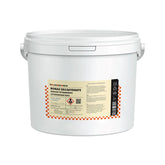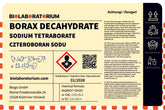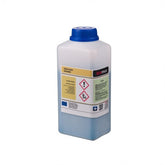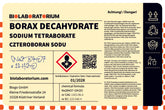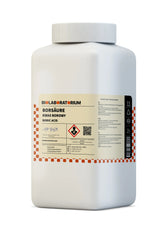Metallophthalein – A colored complexometric indicator for metal ion analysis
In analytical chemistry, complexometric indicators play an important role in the determination of metal ions. One such indicator is metallophthalein, a colored complex that finds diverse applications in metal ion analysis. In this article, we will take a closer look at the properties and uses of metallophthalein.
Basics of Metallophthalein
Metallophthalein is an organic dye that shows characteristic color changes in complexation reactions with metal ions. The indicator consists of an aromatic backbone to which various functional groups are attached. These groups, particularly hydroxyl and carboxyl groups, are capable of complexing metal ions and thus forming metal complexes.
The color change of metallophthalein depends on the metal ion with which the indicator reacts. For example, metallophthalein forms a blue-green complex with copper ions, while the complex with calcium ions exhibits a reddish coloration. These characteristic color changes make metallophthalein a useful tool in qualitative and quantitative metal ion analysis.
Complexation Reactions of Metallophthalein
The mechanism of complex formation of metallophthalein can be described as follows:
- Deprotonation: First, the hydrogen ions dissociate from the hydroxyl and carboxyl groups of the indicator, resulting in negatively charged complexing groups.
- Complex Formation: The now reactive groups can then form bonds with metal ions and form stable metal complexes.
- Color Change: The complex formation leads to a change in the electronic structure of the indicator, which manifests as a characteristic color change.
The stability and color of the metal complexes depend on various factors, such as the charge and coordination geometry of the metal ion, the strength of the ligand-metal bonds, and the polarity of the solvent.
Applications of Metallophthalein
Due to its versatile complexation properties, metallophthalein finds numerous applications in analytical chemistry:
Qualitative Metal Ion Analysis
Metallophthalein can be used as a color indicator for the qualitative determination of metal ions. By observing the characteristic color changes, various metal ions such as copper, calcium, magnesium, or iron can be detected.
Complexometric titration
In complexometric titration, Metallophthalein is used as an indicator to detect the endpoint of titration with complexing agents such as EDTA. Based on the color change, the consumption of titration solution and thus the concentration of the metal ion can be determined.
Metal ion determination in foods
Metallophthalein is used in food analysis to determine metal traces in foods and beverages. For example, the calcium content in dairy products or the iron content in mineral waters can be analyzed with it.
Water analysis
In water analysis, Metallophthalein is used to determine hardness-forming ions such as calcium and magnesium ions in waters. The content of heavy metal ions in water bodies can also be monitored with it.
Medical applications
In medicine, Metallophthalein is used for determining metal ions in blood or urine. For example, copper status in diseases such as Wilson's disease can be investigated.
Advantages and limitations of Metallophthalein
As a complexometric indicator, Metallophthalein offers several advantages:
- High sensitivity and selectivity towards various metal ions
- Simple handling and application in routine analysis
- Cost-effective and readily available substance
However, Metallophthalein also has some limitations:
- Color change can be influenced by factors such as pH, solvent, and temperature
- Not equally suitable for all metal ions, possible interferences in some cases
- Toxicity must be considered during handling and disposal
Despite these limitations, Metallophthalein remains an important complex indicator in analytical chemistry and finds application in many areas.
Conclusion
Metallophthalein is a versatile complexometric indicator widely used in qualitative and quantitative metal ion analysis. Its characteristic color changes during complex formation with various metal ions make it a useful tool in analytical practice. Despite some limitations, Metallophthalein offers many advantages due to its sensitivity, selectivity, and ease of handling, and is indispensable in modern analytics.

